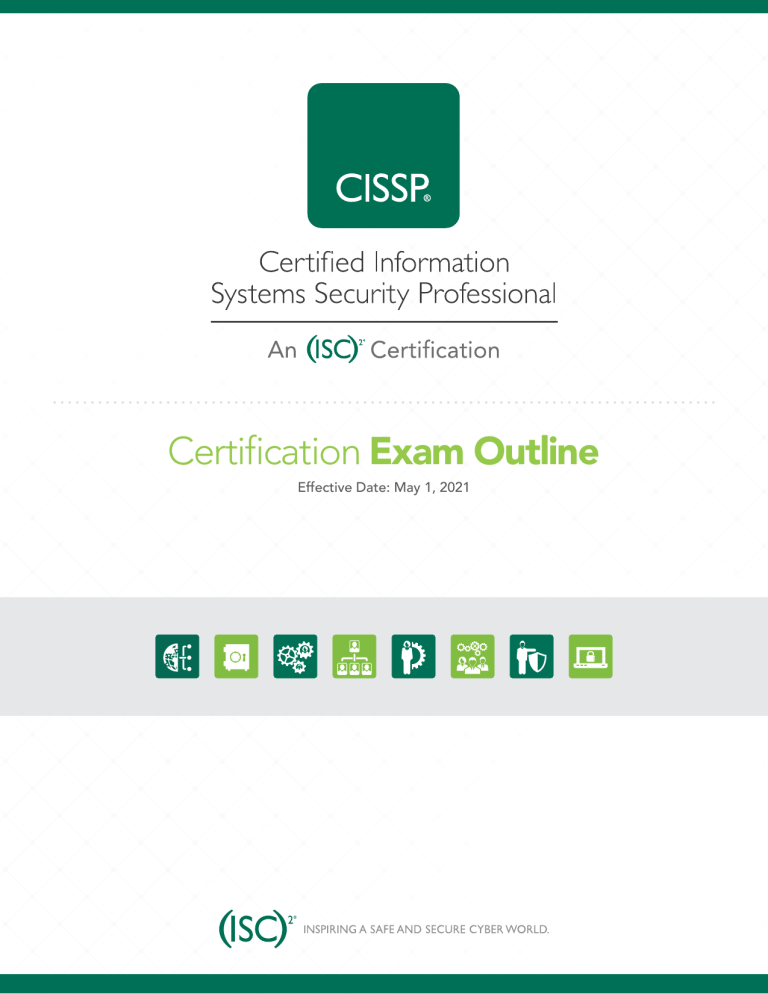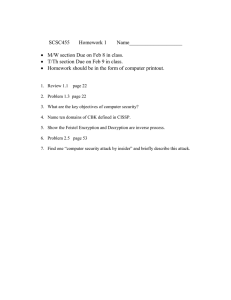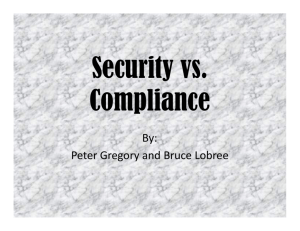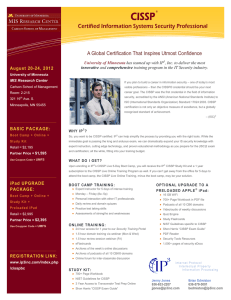
Certification Exam Outline Effective Date: May 1, 2021 About CISSP The Certified Information Systems Security Professional (CISSP) is the most globally recognized certification in the information security market. CISSP validates an information security professional’s deep technical and managerial knowledge and experience to effectively design, engineer, and manage the overall security posture of an organization. The broad spectrum of topics included in the CISSP Common Body of Knowledge (CBK®) ensure its relevancy across all disciplines in the field of information security. Successful candidates are competent in the following eight domains: • • • • • • • • Security and Risk Management Asset Security Security Architecture and Engineering Communication and Network Security Identity and Access Management (IAM) Security Assessment and Testing Security Operations Software Development Security Experience Requirements Candidates must have a minimum of five years cumulative paid work experience in two or more of the eight domains of the CISSP CBK. Earning a four year college degree or regional equivalent or an additional credential from the (ISC)2 approved list will satisfy one year of the required experience. Education credit will only satisfy one year of experience. A candidate that doesn’t have the required experience to become a CISSP may become an Associate of (ISC)2 by successfully passing the CISSP examination. The Associate of (ISC)2 will then have six years to earn the five years required experience. You can learn more about CISSP experience requirements and how to account for part-time work and internships at www.isc2.org/Certifications/CISSP/experience-requirements. Accreditation CISSP was the first credential in the field of information security to meet the stringent requirements of ANSI/ ISO/IEC Standard 17024. Job Task Analysis (JTA) (ISC)2 has an obligation to its membership to maintain the relevancy of the CISSP. Conducted at regular intervals, the Job Task Analysis (JTA) is a methodical and critical process of determining the tasks that are performed by security professionals who are engaged in the profession defined by the CISSP. The results of the JTA are used to update the examination. This process ensures that candidates are tested on the topic areas relevant to the roles and responsibilities of today’s practicing information security professionals. CISSP Certification Exam Outline 2 CISSP CAT Examination Information The CISSP exam uses Computerized Adaptive Testing (CAT) for all English exams. CISSP exams in all other languages are administered as linear, fixed-form exams. You can learn more about CISSP CAT at www.isc2.org/certificatons/CISSP-CAT. Length of exam 3 hours Number of items 100 - 150 Item format Multiple choice and advanced innovative items Passing grade 700 out of 1000 points Exam language availability English Testing center (ISC)2 Authorized PPC and PVTC Select Pearson VUE Testing Centers CISSP CAT Examination Weights Domains Average Weight 1. Security and Risk Management 15% 2. Asset Security 10% 3. Security Architecture and Engineering 13% 4. Communication and Network Security 13% 5. Identity and Access Management (IAM) 13% 6. Security Assessment and Testing 12% 7. Security Operations 13% 8. Software Development Security 11% Total: CISSP Certification Exam Outline 100% 3 CISSP Linear Examination Information Length of exam 6 hours Number of items 250 Item format Multiple choice and advanced innovative items Passing grade 700 out of 1000 points Exam language availability French, German, Brazilian Portuguese, Spanish-Modern, Japanese, Simplified Chinese, Korean Testing center (ISC)2 Authorized PPC and PVTC Select Pearson VUE Testing Centers CISSP Linear Examination Weights Domains Weight 1. Security and Risk Management 15% 2. Asset Security 10% 3. Security Architecture and Engineering 13% 4. Communication and Network Security 13% 5. Identity and Access Management (IAM) 13% 6. Security Assessment and Testing 12% 7. Security Operations 13% 8. Software Development Security 11% Total: CISSP Certification Exam Outline 100% 4 Domain 1: Security and Risk Management 1.1 Understand, adhere to, and promote professional ethics » (ISC)2 Code of Professional Ethics » Organizational code of ethics 1.2 Understand and apply security concepts » Confidentiality, integrity, and availability, authenticity and nonrepudiation 1.3 Evaluate and apply security governance principles » Alignment of the security function to business strategy, goals, mission, and objectives » Organizational processes (e.g., acquisitions, divestitures, governance committees) » Organizational roles and responsibilities » Security control frameworks » Due care/due diligence 1.4 Determine compliance and other requirements » Contractual, legal, industry standards, and regulatory requirements » Privacy requirements 1.5 Understand legal and regulatory issues that pertain to information security in a holistic context » Cybercrimes and data breaches » Import/export controls » Licensing and Intellectual Property (IP) requirements » Transborder data flow » Privacy 1.6 Understand requirements for investigation types (i.e., administrative, criminal, civil, regulatory, industry standards) 1.7 Develop, document, and implement security policy, standards, procedures, and guidelines CISSP Certification Exam Outline 5 1.8 Identify, analyze, and prioritize Business Continuity (BC) requirements » Business Impact Analysis (BIA) » Develop and document the scope and the plan 1.9 Contribute to and enforce personnel security policies and procedures » Candidate screening and hiring » Compliance policy requirements » Employment agreements and policies » Privacy policy requirements » Onboarding, transfers, and termination processes » Vendor, consultant, and contractor agreements and controls 1.10 Understand and apply risk management concepts » Identify threats and vulnerabilities » Control assessments (security and privacy) » Risk assessment/analysis » Monitoring and measurement » Risk response » Reporting » Countermeasure selection and implementation » Continuous improvement (e.g., Risk maturity modeling) » Applicable types of controls (e.g., preventive, detective, corrective) » Risk frameworks 1.11 Understand and apply threat modeling concepts and methodologies 1.12 Apply Supply Chain Risk Management (SCRM) concepts » Risks associated with hardware, software, and services » Third-party assessment and monitoring » Minimum security requirements » Service level requirements 1.13 Establish and maintain a security awareness, education, and training program » Methods and techniques to present awareness and training (e.g., social engineering, phishing, security champions, gamification) » Periodic content reviews » Program effectiveness evaluation CISSP Certification Exam Outline 6 Domain 2: Asset Security 2.1 Identify and classify information and assets » Data classification » Asset Classification 2.2 Establish information and asset handling requirements 2.3 Provision resources securely » Information and asset ownership » Asset inventory (e.g., tangible, intangible) » Asset management 2.4 Manage data lifecycle » Data roles (i.e., owners, controllers, custodians, processors, users/subjects) » Data maintenance » Data collection » Data remanence » Data location » Data retention » Data destruction 2.5 Ensure appropriate asset retention (e.g., End-of-Life (EOL), End-of-Support (EOS)) 2.6 Determine data security controls and compliance requirements » Data states (e.g., in use, in transit, at rest) » Scoping and tailoring » Standards selection » Data protection methods (e.g., Digital Rights Management (DRM), Data Loss Prevention (DLP), Cloud Access Security Broker (CASB)) CISSP Certification Exam Outline 7 Domain 3: Security Architecture and Engineering 3.1 Research, implement and manage engineering processes using secure design principles » Threat modeling » Keep it simple » Least privilege » Zero Trust » Defense in depth » Privacy by design » Secure defaults » Trust but verify » Fail securely » Shared responsibility » Separation of Duties (SoD) 3.2 Understand the fundamental concepts of security models (e.g., Biba, Star Model, Bell-LaPadula) 3.3 Select controls based upon systems security requirements 3.4 Understand security capabilities of Information Systems (IS) (e.g., memory protection, Trusted Platform Module (TPM), encryption/decryption) 3.5 Assess and mitigate the vulnerabilities of security architectures, designs, and solution elements » Client-based systems » Internet of Things (IoT) » Server-based systems » Microservices » Database systems » Containerization » Cryptographic systems » Serverless » Industrial Control Systems (ICS) » Embedded systems » Cloud-based systems (e.g., Software as a Service (SaaS), Infrastructure as a Service (IaaS), Platform as a Service (PaaS)) » High-Performance Computing (HPC) systems » Distributed systems » Edge computing systems » Virtualized systems 3.6 Select and determine cryptographic solutions » Cryptographic life cycle (e.g., keys, algorithm selection) » Key management practices » Cryptographic methods (e.g., symmetric, asymmetric, elliptic curves, quantum) » Non-repudiation » Public Key Infrastructure (PKI) CISSP Certification Exam Outline » Digital signatures and digital certificates » Integrity (e.g., hashing) 8 3.7 Understand methods of cryptanalytic attacks » Brute force » Fault injection » Ciphertext only » Timing » Known plaintext » Man-in-the-Middle (MITM) » Frequency analysis » Pass the hash » Chosen ciphertext » Kerberos exploitation » Implementation attacks » Ransomware » Side-channel 3.8 Apply security principles to site and facility design 3.9 Design site and facility security controls » Wiring closets/intermediate distribution facilities » Server rooms/data centers » Media storage facilities » Evidence storage » Restricted and work area security CISSP Certification Exam Outline » Utilities and Heating, Ventilation, and Air Conditioning (HVAC) » Environmental issues » Fire prevention, detection, and suppression » Power (e.g., redundant, backup) 9 Domain 4: Communication and Network Security 4.1 Assess and implement secure design principles in network architectures » Open System Interconnection (OSI) and Transmission Control Protocol/Internet Protocol (TCP/IP) models » Internet Protocol (IP) networking (e.g., Internet Protocol Security (IPSec), Internet Protocol (IP) v4/6) » Secure protocols » Implications of multilayer protocols » Converged protocols (e.g., Fiber Channel Over Ethernet (FCoE), Internet Small Computer Systems Interface (iSCSI), Voice over Internet Protocol (VoIP)) » Micro-segmentation (e.g., Software Defined Networks (SDN), Virtual eXtensible Local Area Network (VXLAN), Encapsulation, Software-Defined Wide Area Network (SD-WAN)) » Wireless networks (e.g., Li-Fi, Wi-Fi, Zigbee, satellite) » Cellular networks (e.g., 4G, 5G) » Content Distribution Networks (CDN) 4.2 Secure network components » Operation of hardware (e.g., redundant power, warranty, support) » Transmission media » Network Access Control (NAC) devices » Endpoint security 4.3 Implement secure communication channels according to design » Voice » Data communications » Multimedia collaboration » Virtualized networks » Remote access » Third-party connectivity CISSP Certification Exam Outline 10 Domain 5: Identity and Access Management (IAM) 5.1 Control physical and logical access to assets » Information » Facilities » Systems » Applications » Devices 5.2 Manage identification and authentication of people, devices, and services » Identity Management (IdM) implementation » Federated Identity Management (FIM) » Single/Multi-Factor Authentication (MFA) » Credential management systems » Accountability » Single Sign On (SSO) » Session management » Just-In-Time (JIT) » Registration, proofing, and establishment of identity 5.3 Federated identity with a third-party service » On-premise » Hybrid » Cloud 5.4 Implement and manage authorization mechanisms » Role Based Access Control (RBAC) » Discretionary Access Control (DAC) » Rule based access control » Attribute Based Access Control (ABAC) » Mandatory Access Control (MAC) » Risk based access control 5.5 Manage the identity and access provisioning lifecycle » Account access review (e.g., user, system, service) » Role definition (e.g., people assigned to new roles) » Provisioning and deprovisioning (e.g., on /off boarding and transfers) » Privilege escalation (e.g., managed service accounts, use of sudo, minimizing its use) 5.6 Implement authentication systems » OpenID Connect (OIDC)/Open Authorization (Oauth) » Security Assertion Markup Language (SAML) » Remote Authentication Dial-In User Service (RADIUS)/Terminal Access Controller Access Control System Plus (TACACS+) » Kerberos CISSP Certification Exam Outline 11 Domain 6: Security Assessment and Testing 6.1 Design and validate assessment, test, and audit strategies » Internal » External » Third-party 6.2 Conduct security control testing » Vulnerability assessment » Misuse case testing » Penetration testing » Test coverage analysis » Log reviews » Interface testing » Synthetic transactions » Breach attack simulations » Code review and testing » Compliance checks 6.3 Collect security process data (e.g., technical and administrative) » Account management » Training and awareness » Management review and approval » Disaster Recovery (DR) and Business Continuity (BC) » Key performance and risk indicators » Backup verification data 6.4 Analyze test output and generate report » Remediation » Exception handling » Ethical disclosure 6.5 Conduct or facilitate security audits » Internal » External » Third-party CISSP Certification Exam Outline 12 Domain 7: Security Operations 7.1 Understand and comply with investigations » Evidence collection and handling » Digital forensics tools, tactics, and procedures » Reporting and documentation » Artifacts (e.g., computer, network, mobile device) » Investigative techniques 7.2 Conduct logging and monitoring activities » Intrusion detection and prevention » Log management » Security Information and Event Management (SIEM) » Threat intelligence (e.g., threat feeds, threat hunting) » Continuous monitoring » User and Entity Behavior Analytics (UEBA) » Egress monitoring 7.3 Perform Configuration Management (CM) (e.g., provisioning, baselining, automation) 7.4 Apply foundational security operations concepts » Need-to-know/least privilege » Job rotation » Separation of Duties (SoD) and responsibilities » Service Level Agreements (SLAs) » Privileged account management 7.5 Apply resource protection » Media management » Media protection techniques 7.6 Conduct incident management » Detection » Recovery » Response » Remediation » Mitigation » Lessons learned » Reporting CISSP Certification Exam Outline 13 7.7 Operate and maintain detective and preventative measures » Firewalls (e.g., next generation, web application, network) » Sandboxing » Intrusion Detection Systems (IDS) and Intrusion Prevention Systems (IPS) » Anti-malware » Whitelisting/blacklisting » Third-party provided security services » Honeypots/honeynets » Machine learning and Artificial Intelligence (AI) based tools 7.8 Implement and support patch and vulnerability management 7.9 Understand and participate in change management processes 7.10 Implement recovery strategies » Backup storage strategies » Recovery site strategies » System resilience, High Availability (HA), Quality of Service (QoS), and fault tolerance » Multiple processing sites 7.11 Implement Disaster Recovery (DR) processes » Response » Restoration » Personnel » Training and awareness » Communications » Lessons learned » Assessment 7.12 Test Disaster Recovery Plans (DRP) » Read-through/tabletop » Parallel » Walkthrough » Full interruption » Simulation 7.13 Participate in Business Continuity (BC) planning and exercises 7.14 Implement and manage physical security » Perimeter security controls » Internal security controls 7.15 Address personnel safety and security concerns » Travel » Emergency management » Security training and awareness » Duress CISSP Certification Exam Outline 14 Domain 8: Software Development Security 8.1 Understand and integrate security in the Software Development Life Cycle (SDLC) » Development methodologies (e.g., Agile, Waterfall, DevOps, DevSecOps) » Maturity models (e.g., Capability Maturity Model (CMM), Software Assurance Maturity Model (SAMM)) » Operation and maintenance » Change management » Integrated Product Team (IPT) 8.2 Identify and apply security controls in software development ecosystems » Programming languages » Libraries » Tool sets » Integrated Development Environment (IDE) » Runtime » Continuous Integration and Continuous Delivery (CI/CD) » Security Orchestration, Automation, and Response (SOAR) » Software Configuration Management (SCM) » Code repositories » Application security testing (e.g., Static Application Security Testing (SAST), Dynamic Application Security Testing (DAST)) 8.3 Assess the effectiveness of software security » Auditing and logging of changes » Risk analysis and mitigation 8.4 Assess security impact of acquired software » Commercial-off-the-shelf (COTS) » Open source » Third-party » Managed services (e.g., Software as a Service (SaaS), Infrastructure as a Service (IaaS), Platform as a Service (PaaS)) 8.5 Define and apply secure coding guidelines and standards » Security weaknesses and vulnerabilities at the source-code level » Security of Application Programming Interfaces (APIs) » Secure coding practices » Software-defined security CISSP Certification Exam Outline 15 Additional Examination Information Supplementary References Candidates are encouraged to supplement their education and experience by reviewing relevant resources that pertain to the CBK and identifying areas of study that may need additional attention. View the full list of supplementary references at www.isc2.org/certifications/References. Examination Policies and Procedures (ISC)² recommends that CISSP candidates review exam policies and procedures prior to registering for the examination. Read the comprehensive breakdown of this important information at www.isc2.org/Register-for-Exam. Legal Info For any questions related to (ISC)²’s legal policies, please contact the (ISC)2 Legal Department at legal@isc2.org. Any Questions? (ISC)² Candidate Services 311 Park Place Blvd, Suite 400 Clearwater, FL 33759 (ISC)² Americas Tel: +1.866.331.ISC2 (4722) Email: info@isc2.org (ISC)² Asia Pacific Tel: +(852) 28506951 Email: isc2asia@isc2.org (ISC)² EMEA Tel: +44 (0)203 300 1625 Email: info-emea@isc2.org CISSP Certification Exam Outline v8/2020 16




